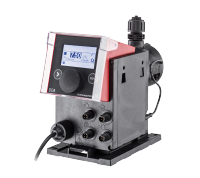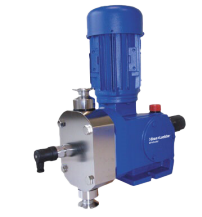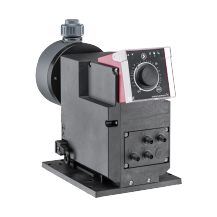Industrial dosing and metering pumps are used to dispense precise amounts of fluids into a system by controlling the flow rate and pump frequency. Different pump types and technologies can be used in a wide range of applications. Offering advantages such as precision, efficiency, safety, and versatility. When selecting your pump, it is important to consider factors such as the flow rate, environment, fluid properties and pump material. AxFlow provides expert advice for selecting, specifying, installing, and maintaining the pump for your needs and application.



Metering Pumps
9 series from 5 manufacturers
-
- Acetate
- Adhesives
- Agriculture
- Bakery and confectionery
- Beauty & Personal Care
- Brewing and beverages
- Ceramics
- Chemical
- Convenience food
- Dairy
- Detergents
- Distilleries
- Drinking Water
- Dye & Pigment
- Emulsions
- Fertilizers
- Fish Farming
- Food & Beverage
- Heating, Water & Sanitation
- Meat Processing
- Oil & Gas
- Oil Fats & Mayonnaise
- Paint & Surface Coating
- Paints & Resins
- Paper Mills
- Petrochemical
- Pharmaceutical
- Plastic
- Polymer Extraction
- Refineries
- Research & Development
- Surface Finishing
- Textile
- Wastewater
- Water Treatment
-
- Analysis
- Booster
- Circulation
- Cleaning
- Control
- Conveying
- Cooling
- Descaling
- Desinfection
- Dewatering
- Diagnostic
- Discharge
- Distribution
- Dosing
- Drain
- Drainage
- Dual Dispensing
- Extraction
- Feed
- Filling
- Filtration
- Flow Control
- Greasing
- Grinding
- Handling
- Heating
- High-Pressure
- High-Temperature
- High-Volume
- Injection
- Irrigation
- Level Control
- Lift
- Lifting
- Loading
- Low-Pressure
- Lubrication
- Medium-Pressure
- Metering
- Mixing
- Off-loading
- Powder Coating
- Pressurisation
- Process
- Processing
- Recirculation
- Recovery
- Refueling
- Replacement
- Rinsing
- Sampling
- Settling
- Spraying
- Tempering
- Transfer
- Treatment
- Ultra High-Pressure
- Unloading
- Volumetric Dispensing
- Washing
- Water-Jet Cleaning
- Water-Jet Cutting
-
- Abrasive Liquids
- Acetate
- Acids
- Adhesives
- Alcohols
- Aluminium Oxide Slurry
- Ammonia
- Beer
- Biological Broths and Slurries
- Bitumen
- Carbon Fibers
- Caustic Solutions
- Cereals
- China Clay Slurry
- Chocolate
- CIP Fluids
- Clay
- Coffee
- Concrete
- Cooling Water
- Corrosive Dyes
- Corrosive Liquids
- Crystalline Slurry
- Dairy Products
- Detergents
- Diesel Fuel Oil
- Drinking Water
- Dye Pigment
- Emulsions
- Ethylene Glycol
- Ferric Chloride
- Fertilizers
- Foam Protein
- Fruit and Vegetables
- Fruit Concentrates
- Gels
- Glycol
- High Temperature Oils
- High Viscosity Liquids
- HydrochloricAcid
- Hygienic Liquids
- Irrigation Water
- Lake Water
- Latex
- Light Fluids
- Lime
- Liquid CO2
- Low NPSH
- Low Viscosity Liquids
- LPG
- Meat
- Milk
- Molasses and Syrups
- Must
- Non-Newtonian Fluids
- Oil, Fats and Mayonnaise
- Paints
- Paints Resins
- Personal Care Products
- Pet Food
- Phosphoric Acid
- Plastic
- Process Condensate
- Produced Water
- Radio Active Fluids
- Redox
- Refrigerants
- Rubber
- Sauces
- Seawater
- Sensitive and Viscous Fluids
- Separated Oil Processing
- Sewage
- Silver Nitrate
- Soaps and Detergents
- Solids and Abrasives
- Solvents
- Spirits
- Sulphuric Acids
- Surface Water
- Surfactants
- Synthetic Fibers
- Thermal Oil
- Thin Liquids
- Thixotropic Fluids
- Toluene
- Toxic Liquids
- Ultra Pure Water
- Vegetable Oils
- Vinegar
- Viscose
- Viscous Liquids
- Wastewater
- Water
- Water Hardness
- Wine
- Wort
-
- Abrasion Resistant
- Adjustable-Flow
- Automatic
- Booster Sets
- Chemically Resistant
- CIP
- Close-Coupled
- Compact
- Containment
- Corrosion-Proof
- Direct-Drive
- Double-Acting
- Electric
- Explosion-Proof
- Fish Friendly
- Flange
- Heavy-Duty
- High Temperature
- High-Efficiency
- High-Performance
- Horizontal Mount
- In-Line
- Intrinsically Safe
- Low Shear
- Low-Noise
- Mechanical
- Mixed Flow
- Mobile
- Modular
- Multi-Stage
- Non-Metal
- Oil-Free
- Plastic Lined
- Pneumatic
- Pulse-less
- Rotary
- Rugged
- Sanitary
- Seal-less
- Self-priming
- Single-Stage
- SIP
- Solids Handling
- Variable Speed
Do you need help finding the right pump that meets your needs?
We have experienced experts who are ready to help you!
Get in touch hereHow do dosing pumps and metering pumps work?
Dosing pumps, also known as metering pumps, are used to dispense precise amounts of fluids into a system by controlling the flow rate and pump frequency. Different pump technologies can be used for dosing and metering, all with their own advantages and applications. The following pump types are typically used for dosing and metering:
- Diaphragm pumps (mechanically deflected diaphragm)
- Hydraulic diaphragm pumps (hydraulically deflected diaphragm)
- Plunger metering pumps
- Peristaltic pumps

Advantages
Each pump type and technology comes with its own advantages and disadvantages. However, the general advantages of dosing and metering pumps include:
Precision: Dosing and metering pumps offer precise control of the flow rate, allowing for accurate and consistent delivery of chemicals and other materials regardless of fluid viscosity or differential pressure.
Efficiency: The pumps use less energy than other pump types, allowing for reduced operating costs.
Safety: They are designed to be safe so that they can be used in hazardous environments. Diaphragm and peristaltic metering pumps are especially effective in preventing the pumped fluid from contaminating the pump or the workspace.
Versatility: They are available in a wide range of sizes and can be used to dispense a variety of liquids, including corrosive, hazardous and high-viscosity liquids. Dosing and metering pumps comes in a large choice of types and a wide range of capacities. Making it possible to pump fluids with precision from a few milliliters, e.g., for laboratory use, to 40,000 liters per hour, e.g., for use in process engineering.
Applications
Dosing and metering pumps are highly useful in a wide range of applications and uses where precision is key. From water treatment and cosmetics manufacturing to food processing and chemicals such as oil/gas. From small and highly precise dosing in the microliter to powerful pumping of liquids with pressures up to 1,000 bar.
Common applications and uses include:
Agricultural irrigation: Centre pivot irrigation systems require the injection of nitrogen into the system as water is pulled from a pond, river, or local source. The water is sent onto the pivoting points where the water is applied to crops, at these pivot points metering pumps can be set up to accurately water the crops with the right amount of nitrogen.
Food and beverage processing: Dosing and metering pumps are widely used in the food and beverage processing industry, where accuracy, safety and reliability are paramount. Here the pumps can be used for blending liquid ingredients or for dosing oils, fats, perishable media and sterile liquids with shear-sensitive particles. The pumps are designed with no dead space to ensure quick and safe CIP cleaning of the pump and valves.
Oil and gas production: Dosing and metering pumps with the necessary API and ATEX certifications are essential in the oil and gas industry to ensure safety and efficiency. By injecting chemicals such as methanol, nonethylene glycol, and corrosion inhibitors into the flow of gas and oil, they help to prevent the formation of hydrates, wax, and scale buildup, while also protecting against corrosion. Not only does this increase production rates, but it also provides an additional layer of security against leaks and spills, making operations more secure and reliable.
Water & Wastewater: Water is in short supply, so experts are needed when producing it for human consumption. To ensure compliance with local statutory requirements. Oxidation, membrane filtration and desalination make the water palatable. Disinfection solutions also guarantee absolute disinfection safety. Depending on the nature of the wastewater, certain values must be checked and, if required, regulated (flocculation, disinfection, phosphoric acid, pH etc.).
Important considerations when selecting the right pump
As several different pump types and technologies can be used for dosing and metering, selecting the right pump type for your application and requirements is crucial.
Flow rate: Knowing your desired flow rate is one of the most important factors to consider. We recommend that the expected flow rate does not exceed 90% of the pump’s capacity. This allows for flexibility in case of sudden increases in flow rate and ensures that the pump is not overloaded.
Environment of operation: The operating environment has a major influence on pump performance. Will it be exposed to direct sunlight or extreme cold temperatures? If you anticipate the pump to be used in a cold climate, make sure to check that the fluid being pumped won't freeze at the low temperatures. Considering the environment of operation ahead of time will help ensure optimal performance and longevity of the pump.
Fluid properties: The composition of the fluid should influence the size and type of pump. Most dosing and metering pumps are designed to handle a range of viscosities; however, modifications may be needed for fluids with a higher viscosity. Thicker fluids may require specialized fluid ends, while extremely thick liquids containing solids may require special diaphragms in order to effectively operate.
Pump material: The parts that make up the pumps must be able to withstand the harsh conditions they will be exposed to. Many industries handle corrosive chemicals or abrasive materials that require more robust pump components. If you are dealing with this type of fluid, you may need to explore parts made of materials such as stainless steel that is known for its corrosion-resistance and durability.
Why buy dosing pumps from AxFlow
AxFlow offers dosing pumps, metering pumps and accessories for the widest range of industries and applications. Only at AxFlow do you receive individual advice from industry-experienced process engineers and the manufacturer-independent selection of the world's leading process technology. Do you need support in selecting the right pump for your needs? Do not hesitate to get in touch. AxFlows experts and engineers can provide guidance for selecting, specifying, installing and maintaining your pump.









